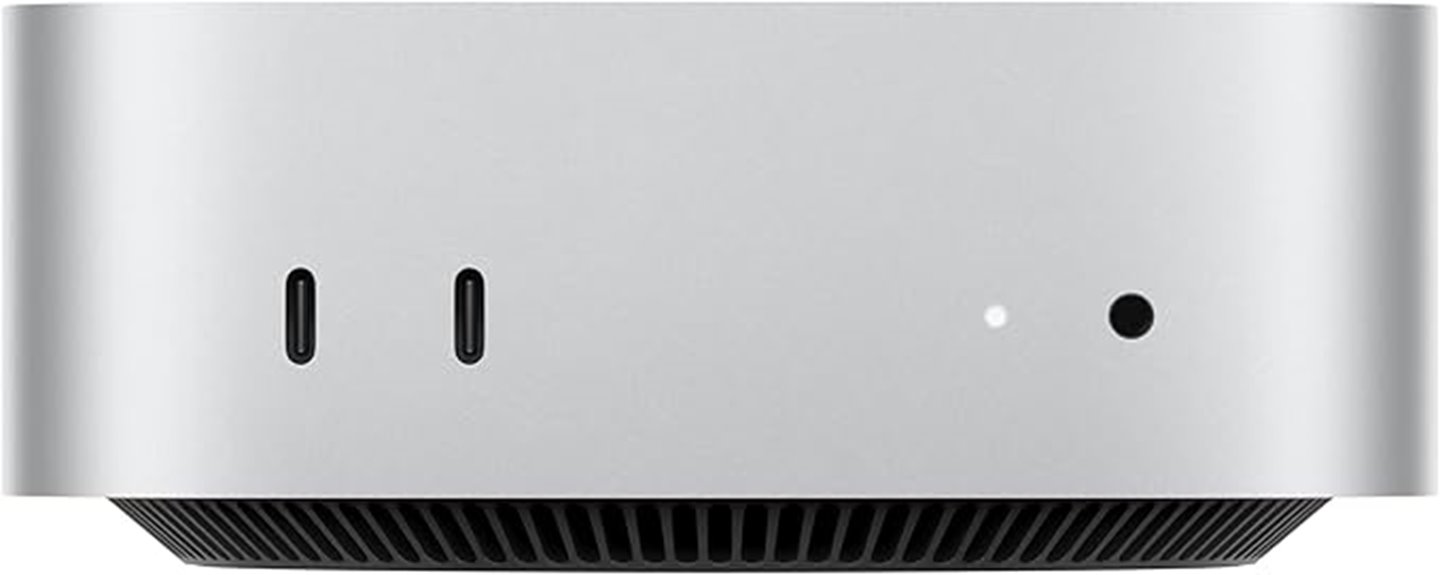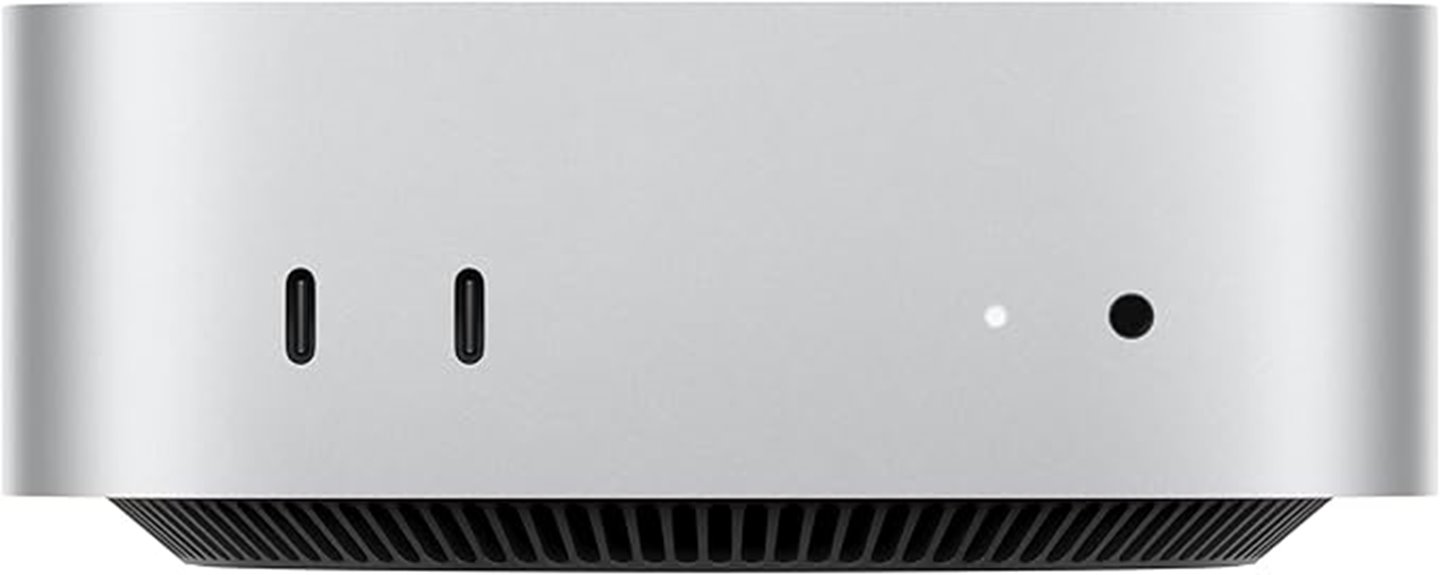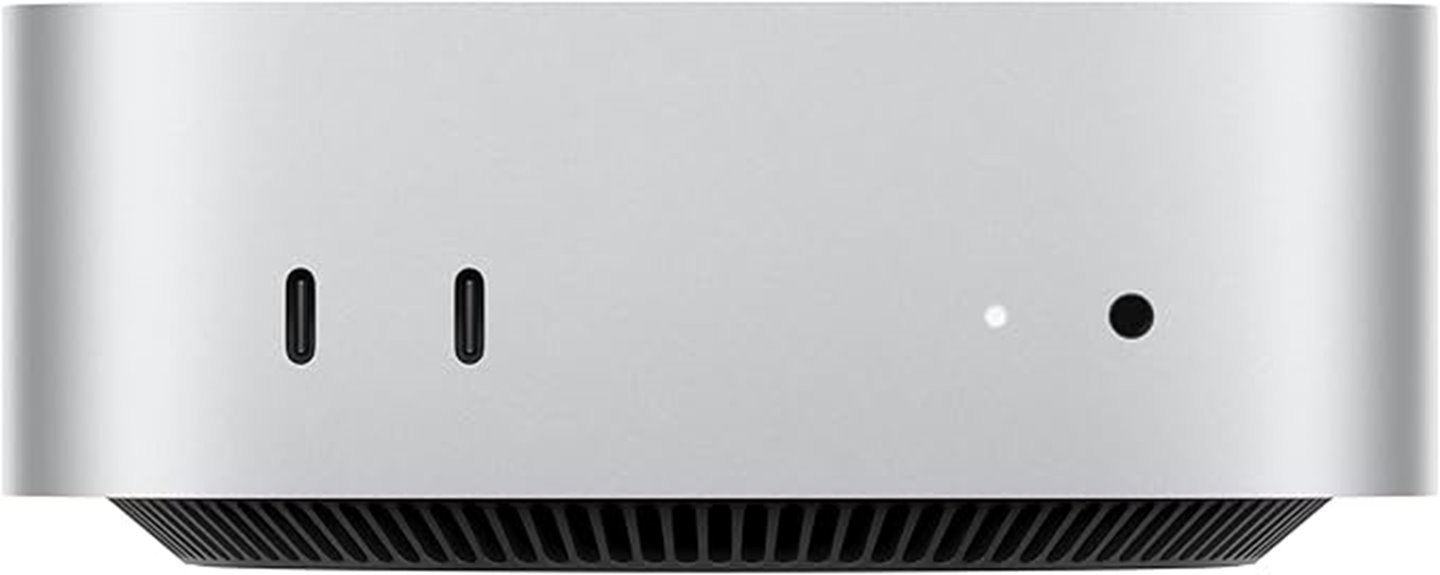Based on 2025’s latest, the top Mac Studios for machine learning combine power, speed, and efficiency. The M4 Pro models stand out with high-core CPUs, advanced neural engines, and large memory options, ideal for demanding ML tasks. The compact design and integrated AI features make them a strong choice. If you want to optimize your ML workflows, exploring these options will reveal the best features for your needs. Keep going to discover more.
Key Takeaways
- Opt for Mac Studios with M4 Pro chips for superior ML processing power and neural engine performance.
- Prioritize models with 32GB+ RAM and fast memory bandwidth to handle large datasets and complex models efficiently.
- Choose configurations supporting high-capacity storage (up to 8TB) and external expandability for scalable workflows.
- Ensure seamless compatibility with ML frameworks like TensorFlow and PyTorch, and check GPU support for accelerated training.
- Consider environmental features and connectivity options like Thunderbolt 5 for future-proofing and versatile setup.
Apple Mac mini 2024 Desktop Computer with M4 Chip

If you’re looking for a compact yet powerful machine learning workstation, the Apple Mac mini 2024 with the M4 chip is an excellent choice. Its 10-core CPU, 10-core GPU, and 16-core Neural Engine deliver impressive performance for demanding ML tasks. The device’s small size—just 5×5 inches and 2 inches tall—makes it perfect for tight spaces, yet it packs full power thanks to redesigned Apple silicon. With 24GB of unified memory, configurable to 32GB, and storage options up to 2TB, it handles large datasets smoothly. Plus, its support for multiple high-resolution displays and fast connectivity makes it a versatile, efficient workhorse.
Best For: professionals and enthusiasts seeking a compact, high-performance machine learning workstation with excellent connectivity and display support.
Pros:
- Powerful M4 chip with 10-core CPU and GPU, plus a 16-core Neural Engine for demanding ML tasks
- Compact size (5×5 inches, 2 inches tall) that fits easily into tight spaces
- Supports multiple high-resolution displays and fast connectivity options
Cons:
- Limited upgradeability due to integrated Apple silicon and fixed RAM/storage options
- Premium price point compared to comparable PC workstations
- May require additional peripherals for complete workstation setup
Apple Mac mini Desktop Computer with M4 Chip (2024)

Looking for a compact yet powerful machine learning workstation? The Apple Mac mini with M4 chip (2024) packs impressive performance into a tiny, five-by-five-inch design. It features a 10-core CPU, 10-core GPU, and 16-core Neural Engine, making it ideal for demanding ML tasks. With 120GB/s memory bandwidth, hardware-accelerated media engines, and up to 32GB of unified memory, it handles large datasets effortlessly. Its versatile connectivity, supporting multiple high-resolution displays and fast ports, complements its performance. Plus, it runs macOS seamlessly, integrates well with Apple’s ecosystem, and is environmental-friendly. This Mac mini proves small size doesn’t mean small power.
Best For: professionals and enthusiasts seeking a compact, high-performance machine learning workstation with seamless Apple ecosystem integration.
Pros:
- Small, space-efficient design ideal for clutter-free setups
- Powerful M4 chip with dedicated neural engine and hardware-accelerated media engines for ML tasks
- Versatile connectivity supporting multiple high-resolution displays and fast ports
Cons:
- Limited internal storage options starting at 256GB, which may require external solutions for large datasets
- Up to 32GB of unified memory might be insufficient for extremely large or complex ML models
- Non-upgradable hardware components, requiring careful initial configuration
Apple Mac mini Desktop with M4 Pro Chip

The Apple Mac mini Desktop with M4 Pro Chip stands out as an ideal choice for those seeking powerful machine learning capabilities in a compact form. Its 12-core CPU, 16-core GPU, and Neural Engine deliver impressive processing speed and efficiency, supporting demanding ML tasks. With 24GB of unified memory, expandable up to 64GB, and storage options up to 8TB, it handles large datasets effortlessly. Its versatile ports, including Thunderbolt 5 and HDMI, support multiple high-resolution displays. Plus, its environmentally friendly, carbon-neutral manufacturing aligns with eco-conscious values. This tiny powerhouse seamlessly integrates with Apple’s ecosystem, making it perfect for creative workflows and intensive machine learning projects.
Best For: creative professionals, developers, and machine learning enthusiasts seeking a powerful, compact, and eco-friendly desktop with seamless Apple ecosystem integration.
Pros:
- High-performance M4 Pro chip with 12-core CPU and 16-core GPU for demanding tasks
- Versatile connectivity including Thunderbolt 5, HDMI, and multiple USB-C ports
- Environmentally friendly, carbon-neutral manufacturing aligning with eco-conscious values
Cons:
- Limited to macOS, which may not suit users needing Windows or Linux compatibility
- Upgradable components are limited post-purchase (e.g., memory and storage)
- Premium price point might be a barrier for budget-conscious buyers
Apple Mac mini Desktop Computer with M4 Chip (512GB SSD, 16GB RAM)

For machine learning professionals seeking a compact yet powerful setup, the Apple Mac mini with M4 chip stands out as an excellent choice. Its small footprint measures just 5×5 inches and weighs only 1.5 pounds, making it easy to place anywhere. Despite its size, it packs a 10-core CPU, 10-core GPU, and a 16-core Neural Engine, delivering impressive performance for demanding tasks. With 16GB of unified memory and a 512GB SSD, it handles large datasets smoothly. The Mac mini offers versatile connectivity, supporting multiple high-resolution displays and fast data transfer, all while maintaining Apple’s commitment to environmental sustainability.
Best For: machine learning professionals and data scientists seeking a compact, high-performance desktop capable of handling demanding workloads with ease.
Pros:
- Compact size with a sleek design that fits easily next to monitors or in limited workspace
- Powerful M4 chip with 10-core CPU, 10-core GPU, and Neural Engine for efficient machine learning tasks
- Seamless compatibility with macOS, Apple Silicon optimized apps, and high-resolution displays
Cons:
- Limited upgradeability due to integrated memory and storage configurations
- Higher cost may be a concern compared to comparable PC alternatives with similar specs
- Only supports up to three displays, which might be restrictive for extensive multi-monitor setups
Factors to Consider When Choosing Mac Studio for Machine Learning

When choosing a Mac Studio for machine learning, I focus on processing power, GPU performance, and memory size to handle demanding tasks effectively. I also consider storage options and expandability to support large datasets and future upgrades, along with compatibility with popular ML tools. These factors ensure I select a setup that’s powerful, flexible, and ready for my projects.
Processing Power Needs
Choosing the right Mac Studio for machine learning hinges on understanding its processing power needs, which vary based on the complexity of your models and dataset sizes. For large-scale tasks, higher core counts in CPUs or GPUs can dramatically cut training times. Hardware with specialized accelerators, like neural engines or tensor cores, boosts performance in deep learning workloads. If you’re working on real-time inference, sufficient processing power guarantees low latency and high throughput. As your projects grow more complex, scaling up processing capabilities becomes essential to handle larger datasets and more sophisticated models simultaneously. Balancing these factors helps you select a Mac Studio that meets your current needs while supporting future expansion, ensuring you get the best performance for your machine learning tasks.
GPU Performance Capacity
GPU performance capacity is a critical factor that directly influences how quickly and efficiently your machine learning models train, especially for large neural networks. A GPU with more cores and higher CUDA or GPU compute units provides greater parallel processing power, speeding up complex algorithms. Hardware-accelerated ray tracing and specialized media engines can boost performance in AI workloads involving graphics or video tasks. The VRAM size on the GPU determines how much data can be processed at once, which is essential when working with large datasets or high-resolution inputs. Compatibility with machine learning frameworks like TensorFlow or PyTorch also depends on specific GPU features, such as CUDA cores or Metal support. Overall, selecting a GPU with robust performance capacity is crucial for efficient, high-quality machine learning workflows.
Memory Size and Speed
A key factor in selecting the right Mac Studio for machine learning is its memory size and speed, as these directly impact how efficiently your models train and process data. Larger memory capacities, like 32GB or more, enable handling of large datasets and complex models without bottlenecks. Faster memory speeds, such as 120GB/s bandwidth, improve data transfer rates between the CPU/GPU and memory, markedly reducing training times. Increasing memory bandwidth prevents slowdowns during intensive computations, especially when training neural networks. Configurable memory options allow you to tailor performance to specific workloads, balancing cost and capability. Having sufficient high-speed memory is essential when running multiple models simultaneously or working with high-resolution data, ensuring smooth performance and minimizing delays during demanding tasks.
Storage and Expandability
When selecting a Mac Studio for machine learning, storage capacity and expandability play a significant role in guaranteeing smooth workflows. Large datasets and models require ample space, so consider options ranging from 512GB to multiple terabytes. Look for expandable storage solutions or the ability to connect external drives, which help accommodate data growth without replacing your entire system. Ensure the device supports fast transfer protocols like Thunderbolt 4 or USB 4, enabling quick movement of large files. Check if the system allows hardware upgrades or additional SSDs to boost storage over time, giving you flexibility as your needs evolve. Balancing built-in storage with external options helps optimize both speed and capacity, ensuring your workflow remains efficient and scalable.
Compatibility With ML Tools
Are you confident that your Mac Studio can handle the machine learning tools you rely on? Confirming compatibility means checking that the GPU, like the M4 Pro’s 16-core GPU, can efficiently support ML computations. You’ll also want to verify that your Mac supports frameworks like TensorFlow or PyTorch, which often need specific hardware acceleration features. Sufficient unified memory—24GB or more—is vital for managing large datasets and training models smoothly. If your workflows involve multimedia data, verify that the hardware-accelerated ray tracing and media engines are compatible. FINALLY, consider the connectivity options to integrate external GPUs or accelerators if your projects demand extra power. These factors guarantee your Mac Studio is up to the task for all your machine learning needs.
Frequently Asked Questions
How Does GPU Performance Impact Machine Learning Tasks on Mac Studios?
GPU performance is vital for machine learning tasks on Mac Studios because it determines how quickly and efficiently I can process large datasets and complex models. A powerful GPU accelerates training times, improves accuracy, and handles parallel computations seamlessly. When GPU performance is exceptional, I notice smoother workflows and faster results, making my machine learning projects more productive and less frustrating.
Are There Specific Mac Studio Models Better Suited for Deep Learning?
If you’re diving into deep learning, I’d recommend the Mac Studio with the M2 Ultra chip. It’s like a powerhouse engine, blending raw power with advanced GPU cores, perfect for heavy-duty ML tasks. The Mac Studio with M2 Max is also solid, but the Ultra version offers more GPU cores and memory. Visualize a race car—more horsepower means faster training and smoother workflows for deep learning projects.
What Is the Typical Power Consumption of Mac Studios During Intensive ML Workloads?
During intensive ML workloads, I’ve found that Mac Studios typically consume around 300 to 350 watts. This power usage varies depending on the model and workload complexity, but I notice the system stays remarkably efficient despite high demands. I always make sure my setup has proper cooling and power sources to handle this level of power consumption comfortably, ensuring smooth, reliable performance during deep learning tasks.
Can Mac Studios Be Upgraded for Future Machine Learning Software Requirements?
Upgrading Mac Studios for future ML needs is limited by their design. While I wish they offered extensive hardware upgrades, Apple’s focus on integrated systems means you’re mostly confined to external enhancements like better GPUs or RAM upgrades during purchase. I advise investing in the highest specs upfront. This way, you make certain your Mac Studio stays relevant as ML software demands evolve, even if internal upgrades are restricted.
How Does Thermal Management Affect Long-Term ML Training on Mac Studios?
Thermal management is vital for long-term ML training on Mac Studios because it keeps the hardware cool, preventing overheating and throttling. When my Mac runs too hot, performance drops, and hardware risks damage. Good airflow and cooling systems help maintain consistent performance, ensuring I can train models longer without interruptions. Proper thermal management ultimately extends my Mac’s lifespan and keeps my machine running efficiently during intensive learning tasks.
Conclusion
In the end, choosing the right Mac Studio for machine learning is all about finding the perfect fit for your needs. Don’t put all your eggs in one basket—consider your project scope, budget, and power requirements. With the right machine, you’ll be ahead of the game and ready to hit the ground running. Remember, it’s better to be safe than sorry, so pick wisely and stay sharp!









